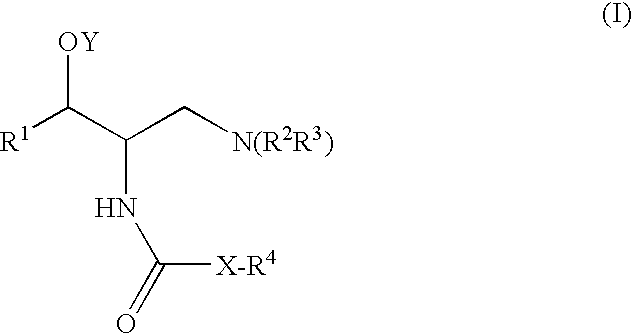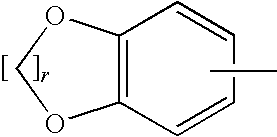2-acylaminopropoanol-type glucosylceramide synthase inhibitors
a technology of glucosylceramide and acylaminopropoanol, which is applied in the direction of biocide, drug composition, metabolic disorder, etc., can solve the problems of gm1 accumulation in the nervous system, mental retardation and liver enlargement, and serious disorders, and achieves high metabolic stability at the liver, the effect of inhibiting glucosylceramide synthesis
- Summary
- Abstract
- Description
- Claims
- Application Information
AI Technical Summary
Benefits of technology
Problems solved by technology
Method used
Image
Examples
example 1
General Methods for the Preparation of Compounds of the Invention
[0364]A general method for the synthesis of final compounds is depicted in Scheme 1. A general method for the preparation of the compounds of the invention involves the reaction of the amine of type EVII with the appropriate reagent. The amine type EVII, such as (1R,2R)-2-amino-(2,3-dihydrobenzo[β][1,4]dioxin-6-yl)-3-(pyrrolidin-1-yl) propan-1-ol, can be prepared according to the preparation of intermediate 4 of U.S. Pat. No. 6,855,830 (the entire teachings of which are incorporated herein by reference), or by using the general synthetic procedures depicted in schemes 2-5. Final amide compounds, EIX can be prepared by reaction of the amine EVII with the corresponding acylating agent using standard reaction conditions for the formation of an amide. The urea compounds, EIIX can be prepared by reaction of the amine EVII with the corresponding isocyanate. The carbamates, EX can be prepared by reaction of the amine EVII wit...
example 1a
Synthesis of the Compounds of the Invention: General Methods for the Preparation of Amide Analogs
Method 1
[0365]A mixture of Compound EVII (1 mmol), such as (1R,2R)-2-amino-1-(2,3-dihydrobenzo[β][1,4]dioxin-6-yl)-3-(pyrrolidin-1-yl)propan-1-ol, prepared according to the preparation of intermediate 4 of U.S. Pat. No. 6,855,830 (the entire teachings of which are incorporated herein by reference) or using the methods depicted in schemes 2, 3, 4 and 5, an acid (1.2 mmol), DCC (dicyclohexylcarbodiimide, 1.2 mmol) and HOBT (1-hydroxy benzotriazole, 1.2 mmol) was dissolved in CH2Cl2 (5 ml). The mixture was stirred at room temperature and monitored by TLC (thin liquid chromatography) for completion. After completion the mixture was filtered and purified by column chromatography using, for example, a mixture of (CH2Cl2 / MeOH / NH4OH).
Method 2
[0366]A mixture of Compound EVII (1 mmol), such as (1R,2R)-2-amino-1-(2,3-dihydrobenzo[β][1,4]dioxin-6-yl)-3-(pyrrolidin-1-yl)propan-1-ol, prepared accordin...
example 1b
Alternative Synthetic Method for the Preparation of Intermediate EVII. Synthetic Route 4
[0373]An alternative general synthesis of Compound EVII is depicted in Scheme 5. An aldehyde (2 equiv) is condensed with the chiral morpholinone in toluene with removal of water to provide the fused cycloadduct 2. Treatment of 2 with hydrogen chloride in an alcohol solvent such as methanol provides amino acid 3. Removal of the N-benzyl functionality can be accomplished with hydrogen in the presence of a palladium catalyst to afford 4. Cyclization of 4 with triphosgene and base provides ester 5. The ester functionality can be reduced with sodium borohydride, and the resulting alcohol converted to an appropriate leaving group (i.e. tosylate or iodide). Reaction of 6 with a suitable amine in the presence of excess base (e.g. K2CO3) in a polar solvent (e.g. DMSO or CH3CN) affords 7. Final deprotection under basic conditions affords Compound EVII analogs suitable for conversion to the desired amide fi...
PUM
| Property | Measurement | Unit |
|---|---|---|
| Concentration | aaaaa | aaaaa |
Abstract
Description
Claims
Application Information
 Login to View More
Login to View More - R&D
- Intellectual Property
- Life Sciences
- Materials
- Tech Scout
- Unparalleled Data Quality
- Higher Quality Content
- 60% Fewer Hallucinations
Browse by: Latest US Patents, China's latest patents, Technical Efficacy Thesaurus, Application Domain, Technology Topic, Popular Technical Reports.
© 2025 PatSnap. All rights reserved.Legal|Privacy policy|Modern Slavery Act Transparency Statement|Sitemap|About US| Contact US: help@patsnap.com



